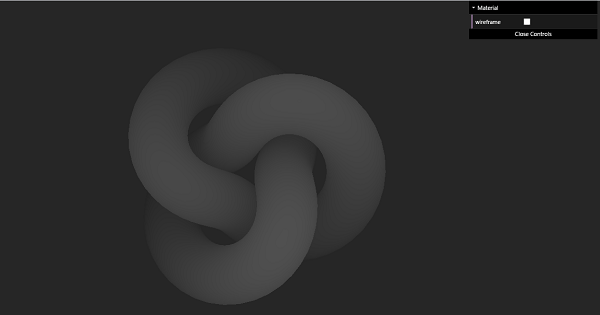
- Three.js - Home
- Three.js - Introduction
- Three.js - Installation
- Three.js - Hello Cube App
- Three.js - Renderer and Responsiveness
- Three.js - Responsive Design
- Three.js - Debug and Stats
- Three.js - Cameras
- Three.js - Controls
- Three.js - Lights & Shadows
- Three.js - Geometries
- Three.js - Materials
- Three.js - Textures
- Three.js - Drawing Lines
- Three.js - Animations
- Three.js - Creating Text
- Three.js - Loading 3D Models
- Three.js - Libraries and Plugins
- Three.js Useful Resources
- Three.js - Quick Guide
- Three.js - Useful Resources
- Three.js - Discussion
Three.js - MeshDepthMaterial
It uses the distance from the camera to determine how to color your mesh in a greyscale. White is nearest, and black is farthest.
const geometry = new THREE.TorusKnotGeometry() const material = new THREE.MeshDepthMaterial() const torusKnot = new THREE.Mesh(geometry, material)
Example
You can understand better in this example.
mesh-depth.html
<!DOCTYPE html>
<html lang="en">
<head>
<meta charset="UTF-8" />
<meta http-equiv="X-UA-Compatible" content="ie=edge" />
<meta name="viewport" content="width=device-width, initial-scale=1.0" />
<title>Three.js - MeshDepthMaterial </title>
<style>
* {
margin: 0;
padding: 0;
box-sizing: border-box;
font-family: -applesystem, BlinkMacSystemFont, 'Segoe UI', Roboto, Oxygen, Ubuntu,
Cantarell, 'Open Sans', 'Helvetica Neue', sans-serif;
}
html,
body {
height: 100vh;
width: 100vw;
}
#threejs-container {
position: block;
width: 100%;
height: 100%;
}
</style>
<script src="https://cdnjs.cloudflare.com/ajax/libs/three.js/r128/three.min.js"></script>
<script src="https://cdnjs.cloudflare.com/ajax/libs/dat-gui/0.7.7/dat.gui.js"></script>
</head>
<body>
<div id="threejs-container"></div>
<script type="module">
// Using mesh depth material
// white means, top point. black means, bottom point
// GUI
const gui = new dat.GUI()
// sizes
let width = window.innerWidth
let height = window.innerHeight// scene
const scene = new THREE.Scene()
scene.background = new THREE.Color(0x262626)
// Light
const ambientLight = new THREE.AmbientLight(0xffffff, 1)
scene.add(ambientLight)
const pointLight = new THREE.PointLight(0xffffff, 0.5)
pointLight.position.x = 2
pointLight.position.y = 3
pointLight.position.z = 4
scene.add(pointLight)
// camera
const camera = new THREE.PerspectiveCamera(30, width / height, 250, 550)
camera.position.z = 450
// torusKnot
const geometry = new THREE.TorusKnotGeometry(50, 20, 128, 64, 2, 3)
const material = new THREE.MeshDepthMaterial()
const materialFolder = gui.addFolder('Material')
materialFolder.add(material, 'wireframe')
materialFolder.open()
const torusKnot = new THREE.Mesh(geometry, material)
scene.add(torusKnot)
// responsiveness
window.addEventListener('resize', () => {
width = window.innerWidth
height = window.innerHlet
camera.aspect = width / height
camera.updateProjectionMatrix()
renderer.setSize(window.innerWidth, window.innerHeight)
renderer.render(scene, camera)
})
// renderer
const renderer = new THREE.WebGL1Renderer({ logarithmicDepthBuffer: true })
renderer.setSize(width, height)
renderer.setPixelRatio(Math.min(window.devicePixelRatio, 2))
// animation
function animate() {
requestAnimationFrame(animate)
torusKnot.rotation.x += 0.005
torusKnot.rotation.y += 0.01
renderer.render(scene, camera)
}
// rendering the scene
const container = document.querySelector('#threejs-container')
container.append(renderer.domElement)
renderer.render(scene, camera)
animate()
</script>
</body>
</html>
Output

threejs_materials.htm
Advertisements